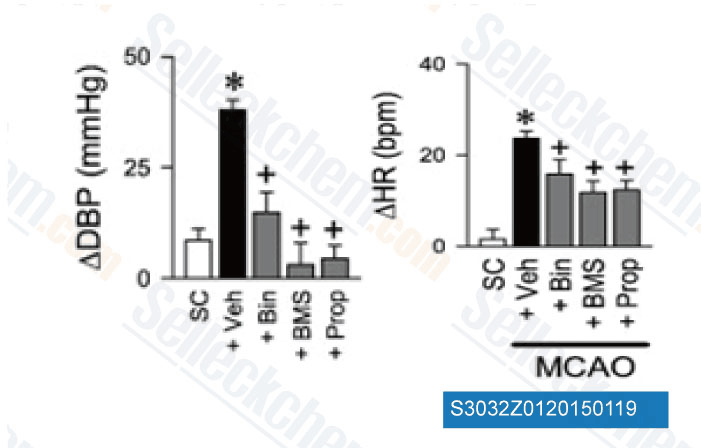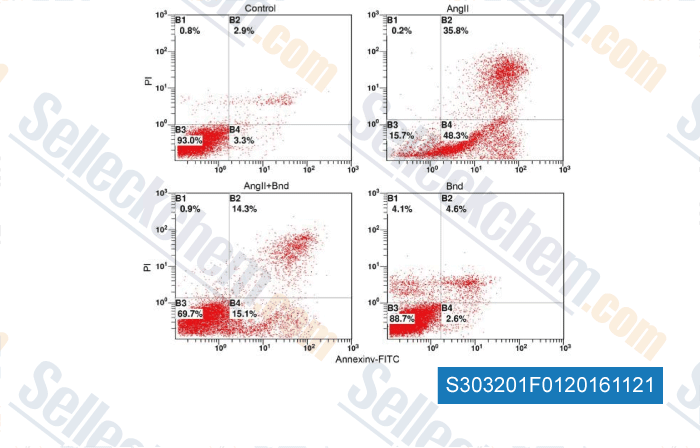|
Toll Free: (877) 796-6397 -- USA and Canada only -- |
Fax: +1-832-582-8590 Orders: +1-832-582-8158 |
Tech Support: +1-832-582-8158 Ext:3 Please provide your Order Number in the email. |
Technical Data
| Formula | C19H20N2O3 |
||||||||||
| Molecular Weight | 324.37 | CAS No. | 130641-38-2 | ||||||||
| Solubility (25°C)* | In vitro | DMSO | 65 mg/mL (200.38 mM) | ||||||||
| Ethanol | 33 mg/mL (101.73 mM) | ||||||||||
| Water | Insoluble | ||||||||||
| In vivo (Add solvents to the product individually and in order) |
|
||||||||||
|
* <1 mg/ml means slightly soluble or insoluble. * Please note that Selleck tests the solubility of all compounds in-house, and the actual solubility may differ slightly from published values. This is normal and is due to slight batch-to-batch variations. * Room temperature shipping (Stability testing shows this product can be shipped without any cooling measures.) |
|||||||||||
Preparing Stock Solutions
Biological Activity
| Description | Bindarit exhibits selective inhibition against monocyte chemotactic proteins MCP-1/CCL2, MCP-3/CCL7 and MCP-2/CCL8. | |||
|---|---|---|---|---|
| Targets |
|
|||
| In vitro | Bindarit treatment causes a dose-dependent inhibition of the capacity of human monocytes to produce monocyte chemotactic protein-1 (MCP-1) in response to bacterial LPS or C. albicans with IC50 of 172 µM and 403 µM, respectively. The inhibition of LP-induced MCP-1 production by Bindarit is associated with reduced levels of MCP-1 mRNA transcripts with IC50 of 75 µM. Bindarit inhibits the production of MCP-1 by LPS-stimulated MM6 cells with IC50 of 425 μM, without affecting the release of IL-8 or IL-6. [2] Bindarit treatment inhibits the release of MCP-1 from IL-1 stimulated osteoblast cell line Saos-2. [3] Bindarit, even at the maximal concentration, does not exhibit a direct in vitro cytotoxic effect on human IIB-MEL-J melanoma or ECs, although it inhibits MCP-1 expression. [4] Bindarit (10-300 μM) reduces rat vascular smooth muscle cell (VSMC) proliferation, migration, and invasion. [5] Bindarit induces the downregulation of the classical NF-κB pathway. Bindarit displays a specific inhibitory effect on the p65 and p65/p50 induced MCP-1 promoter activation, with no effect on other tested activated promoters, indicating that Bindarit acts on a specific subpopulation of NF-κB isoforms and selects its targets within the whole NF-κB inflammatory pathway. [6] Bindarit modulates cancer-cell proliferation and migration, mainly through negative regulation of TGF-β and AKT signaling. [7] |
|||
| In vivo | Oral administration of Bindarit at 50 mg/kg in NZB/W mice delays the onset of proteinuria, significantly protects from renal function impairment, and prolongs survival of NZB/W mice or lupus mice. Bindarit treatment completely MCP-1 up-regulation during the progression of nephritis. [1] Inhibition of MCP-1 with Bindarit also reduces tumor growth and macrophage recruitment, rendering necrotic tumor masses in human melanoma xenografts. [4] Bindarit is effective in reducing neointima formation in both non-hyperlipidaemic and hyperlipidaemic animal models of vascular injury by a direct effect on VSMC proliferation and migration and by reducing neointimal macrophage content. [5] Administration of Bindarit results in impaired metastatic disease in prostate cancer PC-3M-Luc2 xenograft mice and impairment of local tumorigenesis in Balb/c mice with murine breast cancer 4T1-Luc cells. In addition, Bindarit treatment significantly decreases the infiltration of tumor-associated macrophages and myeloid-derived suppressor cells in 4T1-Luc primary tumors. [7] |
|||
| Features | Bindarit is devoid of immunosuppressive effects. |
Protocol (from reference)
| Cell Assay: |
|
|---|---|
| Animal Study: |
|
References
Customer Product Validation

-
Data from [Data independently produced by Neurobiol Dis, 2014, 71, 292-304]

-
Data from [Data independently produced by , , Am J Transl Res, 2016, 8(1):28-36.]
Selleck's Bindarit has been cited by 23 publications
| Nucleus pulposus cells regulate macrophages in degenerated intervertebral discs via the integrated stress response-mediated CCL2/7-CCR2 signaling pathway [ Exp Mol Med, 2024, 56(2):408-421.] | PubMed: 38316963 |
| Trim72 is a major host factor protecting against lethal Candida albicans infection [ PLoS Pathog, 2024, 20(11):e1012747] | PubMed: 39585917 |
| A highly specific antibody against the core fucose of the N-glycan in IgG identifies the pulmonary diseases and its regulation by CCL2 [ J Biol Chem, 2023, S0021-9258(23)02393-1] | PubMed: 37865317 |
| Mesenchymal stem cells alleviate systemic sclerosis by inhibiting the recruitment of pathogenic macrophages [ Cell Death Discov, 2022, 8(1):466] | PubMed: 36435837 |
| Establishment and Characterization of NCC-PMP1-C1: A Novel Patient-Derived Cell Line of Metastatic Pseudomyxoma Peritonei [ J Pers Med, 2022, 12(2)258] | PubMed: 35207746 |
| Establishment and characterization of NCC-UPS4-C1: a novel cell line of undifferentiated pleomorphic sarcoma from a patient with Li-Fraumeni syndrome [ Hum Cell, 2022, 10.1007/s13577-022-00671-y] | PubMed: 35118583 |
| Establishment and characterization of NCC-MFS4-C1: a novel patient-derived cell line of myxofibrosarcoma [ Hum Cell, 2021, 34(6):1911-1918] | PubMed: 34383271 |
| Establishment and characterization of the NCC-GCTB4-C1 cell line: a novel patient-derived cell line from giant cell tumor of bone [ Hum Cell, 2021, 10.1007/s13577-021-00639-4] | PubMed: 34731453 |
| Establishment and characterization of novel patient-derived cell lines from giant cell tumor of bone [ Hum Cell, 2021, 10.1007/s13577-021-00579-z] | PubMed: 34304386 |
| Epigenetic silencing of chemokine CCL2 represses macrophage infiltration to potentiate tumor development in small cell lung cancer [ Cancer Lett, 2020, S0304-3835(20)30632-7] | PubMed: 33253790 |
RETURN POLICY
Selleck Chemical’s Unconditional Return Policy ensures a smooth online shopping experience for our customers. If you are in any way unsatisfied with your purchase, you may return any item(s) within 7 days of receiving it. In the event of product quality issues, either protocol related or product related problems, you may return any item(s) within 365 days from the original purchase date. Please follow the instructions below when returning products.
SHIPPING AND STORAGE
Selleck products are transported at room temperature. If you receive the product at room temperature, please rest assured, the Selleck Quality Inspection Department has conducted experiments to verify that the normal temperature placement of one month will not affect the biological activity of powder products. After collecting, please store the product according to the requirements described in the datasheet. Most Selleck products are stable under the recommended conditions.
NOT FOR HUMAN, VETERINARY DIAGNOSTIC OR THERAPEUTIC USE.
